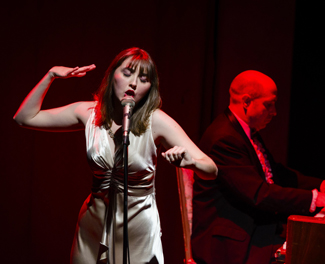
The Rise and Fall of Little Voice is British playwright Jim Cartwright's modern-day fairy tale: its princess is a shy young woman dubbed "Little Voice"—or L.V.—by her boisterous mother, and her prison tower, the shabby public-housing apartment that they share. To muffle the sound of her careless parent's nightly carouses, Little Voice withdraws to her room and the comfort of record albums belonging to her late father. One day, mom's latest boyfriend hears the timid girl mimicking the vinyl-clad pop divas with uncanny accuracy, and hatches a scheme to exploit this hidden talent.
He doesn't succeed, of course, but if we are to cheer on our lonely maiden's ultimate rescue by a working-class prince armed with an electrician's ladder, we must believe in the magic of her shape-shifting vocal powers. In order to play this role, an actress has to deliver spot-on impressions of Judy Garland, Billie Holiday, Edith Piaf, Marilyn Monroe, Shirley Bassey and Cilla Black—and not just their signature classics, either. Don't come to this No Stakes Theater Project's gritty romantic fantasy expecting facile karaoke-party renditions of "Goldfinger" or "Over the Rainbow"
"[Cartwright] permits individual productions to tailor the music to the abilities of the performer cast in the role," says director Erin Shea Brady, "We steered clear of the 'greatest hits' because we wanted the audience to be right there in the moment with the characters, not distracted by nit-picky comparisons to the original."
When Little Voice finally ventures forth onto a cabaret stage, she assumes not only the aural mannerisms of her icons, but their identifying physical stances and movements as well—details she couldn't possibly have learned from records. "Our original technical concept had L.V. watching old movies on television in one scene, but as we rehearsed, this turned out not to be possible." Brady explains ruefully, "The script has her repeat spoken phrases from the films, however—so we decided to let playgoers make the connection, themselves."
What heightens the intensely personal nature of Little Voice's obeisance, says Scarlet Sheppard, who portrays our cloistered heroine, is that they often include the purely mechanical distortions associated with primitive recording equipment—Holiday's nasal mew on "All of Me," for example. "L.V. sings the music as she hears it, not just as pretty songs."
At one point, Little Voice chirps a few notes of Marilyn Monroe's "Happy Birthday, Mister President" but later in the play, belts out Monroe's "Heat Wave" in its entirety. Bassey is represented by "Big Spender," Piaf by "Padam Padam," and Garland by likewise lesser-copied selections from her extensive repertoire. Winnowing down the list wasn't easy, recalls Brady.
"In the beginning, we considered Marlene Dietrich, Blossom Dearie, Barbra Streisand—too many to sift through! The playwright mentions Garland, Monroe, Piaf and Holiday by name, but also some singers not very well-known in the United States, like Cilla Black—who's from Liverpool, by the way, a town not unlike where Little Voice is set—Shirley Bassey and Gracie Fields. We decided to keep Cilla and Shirley, but have them sing songs familiar to American audiences, and swapped out Fields for Julie Andrews."
Sheppard reports audiences responding favorably to Little Voice's transformation and its promise of triumph over oppression. "The space at Theater Wit is so small that I can hear people in the house whispering, 'That's The Sound of Music!' or 'It's Judy!' when they recognize the melody. It's so much fun to go on that journey with them every night!"
The Rise and Fall of Little Voice runs at Theater Wit through September 5.
Mary Shen Barnidge
Contributing Writer

 Follow Us On Twitter
Follow Us On Twitter